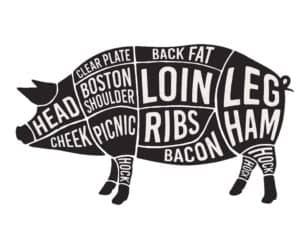The Primal & Subprimal Cuts of Pork

The Primal & Subprimal Cuts of Pork
This guide is designed to help build your vocabulary, understanding, and appreciation for the primal and subprimal cuts of pork. As you read on, you will learn about the various qualities, such as texture and taste, of each cut, as well as the suggested cooking techniques for each.
The Four Primal Cuts of Pork and Each of Their Subprimal Cuts
Pork Leg
Pork leg is very lean and is the source of a diverse selection of butcher shop cuts of meat. When cured and smoked, the pork leg produces ham, and when dry cured and aged, you’ll get prosciutto. Some other cuts of meat from the pork leg include ham steak, schnitzel (cutlets), pork hock, shank ham, and rump ham.
Pork Loin
Pork loin comes from the back of the pig, starting just behind the shoulder and ending at the hip. It is commonly split into three sections: the rib, sirloin, and loin center, but can also be split into only two sections, known as the pork loin rib half and pork loin sirloin half. The pork loin yields some of the most tender subprimal cuts of pork that are ideal for dry heat cooking methods. Cuts from the pork loin include center chop, center back bacon (Canadian bacon), sirloin chop (baby back ribs), and rib chop.
Pork Shoulder
Pork shoulder is considerably fattier than most other primal cuts and is therefore often used to make pork sausage. Some of the subprimal cuts of pork that come from the shoulder include shoulder blade steaks, Boston butt, cottage roll, shoulder picnic, riblets, and jowl.
Pork Belly
Pork belly is the fattiest of the primal cuts, as it is cut from the underside belly area of the pig. Upon removing the ribs, the retail name for pork belly becomes side pork, which is often rolled and processed to produce pancetta. The pork belly contains the side ribs and breastbone and is used to produce side bacon, spareribs, and center-cut side ribs, which are also known as St. Louis ribs.

